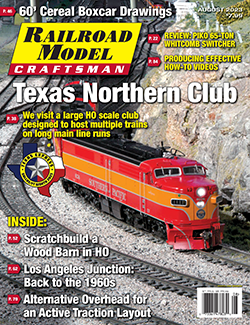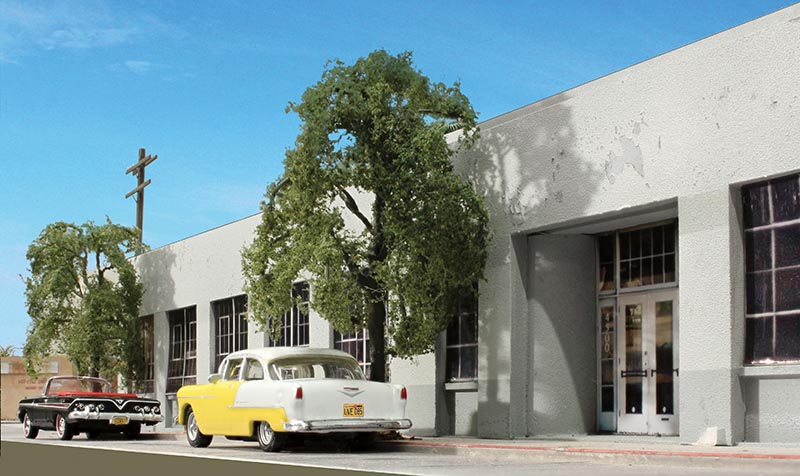 by Lance Mindheim/photos by the author
by Lance Mindheim/photos by the author
I wasn’t looking for anything more than some general hobby reading material when, at age 16, I walked into a hobby shop and picked up the December 1976 issue of Railroad Modeler. Inside was an article by Don Sims titled “This is Switching Country,” documenting the Los Angeles Junction Railway (LAJ). “In this compact but industrialized zone, Los Angeles Junction’s world is one of movement in slow motion, eight frames a minutes instead of 16 frames. The slow moving pace of dragging railroad cars about at low speed brings out every creak and groan imaginable. Flanges squeal around highly turned curves; the springs groan as cars rock side to side, like some bobbly, dancing snake bring to mind questions about mechanical prowess.” Sims, a prolific author who passed away in 2021 at the age of 93, was one of those rare and gifted writers who could literally draw a picture with words and clearly communicate the essence of a railroad theme. I wore out the pages of that issue reading it time and time again.
Many of us can look back in time and pinpoint that one article that drew us in so intensely that it influenced our hobby interests for the rest of our lives. Since tripping over Don’s article decades ago, I’ve been fascinated by industrial switching operations. Time has a way of marching on and, although I put my modeling efforts into other themes, I never totally forgot about the LAJ. With the help of our editor, I tracked down a copy of Don’s article in 2015. Finding it wasn’t easy since the title made no direct reference to the LAJ. But with that story for inspiration in hand — and with some much needed housecleaning, space freed up in the corner of my office — I could finally model my first true prototype passion.

ABOVE: Alco S-2 no. 3 sits outside the engine house adjacent to A Yard preparing for its next assignment. In the distance are the signature electric towers lining the north bank of the Los Angeles River. I didn’t have room on the layout for this engine house facility but wanted it just the same since it shows up in a large number of photos. Rather than force the issue and try to squeeze it in someplace it really wouldn’t fit, I scratchbuilt the structure and put it on a diorama for photography. The sky and tower in the distance were Photoshopped in using an image I shot on a recent trip to California.
My “main” layout featuring CSX switching operations in downtown Miami occupies most of the basement. Because of that I was looking for something small and simple for the LAJ project. I would describe it as an operational diorama. It’s fully functional but serves primarily as a platform for structure-building and photography. Half of the layouts I’ve built over my life have been prototype while the other half, including the LAJ project in the pages that follow, are more of what I’d describe as proto-freelance. I use a section of the prototype for guidance but give myself some flexibility to move elements around to create better composition.
The LAJ is a veritable spider web of branches and it would be impossible to model them all. I settled on a mile-long spur called The Horn Lead as the general basis for the layout. I don’t model it exactly but merely use it for inspiration and guidance, drawing about a third of the elements from areas that aren’t on the spur but located nearby. The challenge with this type of freelancing is making the distinction between “selecting” an element that dovetails into an overall composition as opposed to giving into the natural temptation to cherry-pick. When you aren’t following a prototype exactly, and if you aren’t careful with what you choose to model, you can end up with a toy-like caricature.

ABOVE: The conductor radios instructions to the engineer as they prepare to make the hitch. The iPhone 6 allows for very low angle shots which creates a sense of mass in the models and angles we are more used to seeing when we are railfanning. To create this image, several photos were taken at different focal points and then merged together using a program called Helicon Focus.
The actual LAJ occupies a fairly large but mostly inconspicuous footprint in LA’s Central Manufacturing District. Split right down the middle by the LA River, structures run the mix from one-story art deco and streamlined modern affairs to large and heavy industrial facilities. Following the end of steam, they had a roster of seven Alcos: five S-2s and two S-4s. That was followed by what I call the “CF7 era” starting in 1974. Now power is whatever color of the rainbow BNSF Railway assigns on any particular day.
Located a stone’s throw from Hollywood, the Central Manufacturing District, the LAJ’s home, shows up in movies and television fairly frequently. Season 2 of the HBO series True Detective was filmed there.
As if there wasn’t already enough visual texture in the area, you have the fiefdom of Vernon, a small incorporated city of 100 residents in the middle of the district and once called the “Most Corrupt City in America” by the Los Angeles Times. With a massive tax base, and virtually no population, it was the perfect storm for political corruption. Until the state of California got sick of the shenanigans and swept in, city leaders paid themselves salaries approaching and sometimes exceeding seven figures. As the noose started tightening, one of Vernon’s chief administrators was found floating face down in San Francisco Bay, cause of death being ruled “natural causes.”

ABOVE: The Horn Lead in particular, and Vernon in general, is typified by low-lying, sprawling, single-story Art Deco or “streamline moderne” industrial structures. A 1955 Chevy Bel Air and 1961 Impala sit in front of 4300 District Blvd. This structure was scratchbuilt from styrene sheet. The windows and doors are photographs of the prototype.
With space available and the needed inspiration in hand, I built my version of the LAJ’s Horn Lead over several years starting in 2016. When I originally built the layout it was set in what I’ll call the “CF7 Era” of the 1980s. In order to make things easier at the time, including photography, all of the structures are easily removable. A model railroader’s DNA is such that a fully completed layout goes against our nature and our mind wanders to what other possibilities and themes are out there. I thought it would be fun to backdate the layout to match what I’d read decades ago in the Don Sims article. All I had to do was switch out a few structures, swap in vehicles of the era, and model earlier rolling stock. I loosely settled on what I’ll call California’s “gold license plate era” which ended in 1963.
Join me as we step back in time to 1962 and spend a day railfanning this fascinating road that Don Sims hooked me on as a teenager…


